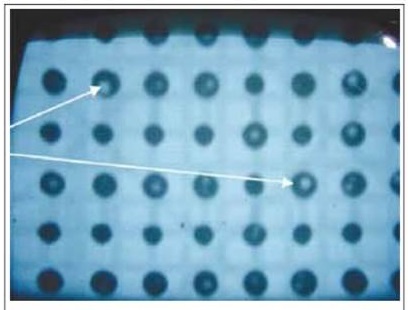Voiding Issues
Issue Description: Commonly caused by gas pockets trapped inside the solder joint.
 1) Modify the reflow profile to generate less volatile material and to give more time for gas to escape.
1) Modify the reflow profile to generate less volatile material and to give more time for gas to escape.
Increasing soak time will reduce voiding for some solder pastes.
Increasing soak time will drive off more of the low boiling volatiles from the solder paste prior to reflow.
Increasing peak temperature will reduce voiding for some solder pastes. Increasing peak temperature gives more heat and time above liquidus which allows volatile materials to escape before the solder joint solidifies.
2) Modify the stencil to give gas escape routes under components (QFN thermal pads are common trouble spots).
5-dice, window pane, cross hatch, and radial solder paste deposits all provide gas escape routes.
Clearances can be created around via holes so that solder paste is not pulled into the via hole during reflow.
3) Switch to a solder paste formulation that has a lower tendency to form voids.
Solder paste formulations with lower volatile content obviously will create lower voiding. For example, WS888 solder paste has lower volatile content than WS889 and will have a reduced tendency to form voids.
No clean solder pastes typically will give lower voiding than water soluble solder pastes. No clean solder pastes usually have lower volatile content than water solubles. No clean solder pastes also have a much lower tendency to absorb moisture from the air. Moisture absorption into the solder paste results in higher voiding.
Solder alloys with a melting range generate lower voiding than eutectic solder alloys. The melting range gives a longer time for complete coalescence of the solder powder, which allows gas to escape before the joint becomes fully liquid. This is easily accomplished in lead free solder pastes by using an alloy with some silver like SAC305.

